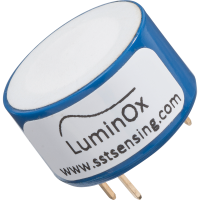LuminOx Outperforms Electrochemical Oxygen Sensors
Electrochemical sensors are sensitive to temperature and therefore require external compensation, using hardware or software methods. LuminOx contains built-in temperature compensation, so removes this requirement. Not only does LuminOx measure and compensate for temperature, but it’s two wire communications interface allows the gas temperature and pressure to be measured and transmitted along with the oxygen value– an added bonus!
The graphs below show how LuminOx’s output remains the constant while the gas temperature is changing. Electrochemical (EC) sensors, tested at the same time, exhibit significant errors as a result of the changing temperature.
The three sensors were supplied with various fixed gas concentrations and the temperature was varied between -20 and +50degC. Figures 1 and 2 below show the results for 0% O₂ and 20% O₂:
LuminOx clearly has significantly less sensitivity to temperature when compared to electrochemical sensors. Electrochemical sensors are also susceptible to rapid changes in temperature. Again, LuminOx is less sensitive to this effect due to its built-in temperature compensation.
The three sensors were supplied with 21% O₂ and the gas temperature was changed as rapidly as possible, using a heat exchanger, between 15 and 40⁰C. The blue line in Figure 3 below is the gas temperature measured inside the test enclosure. The temperature is read on the axis to the right of the graph. The O₂% reported by the three sensors is measured on the left axis.
Although all the sensors have some sensitivity to temperature changes, LuminOx is significantly less sensitive to them.
Electrochemical sensors are also extremely sensitive to changes in the gas pressure, even when the O₂ concentration remains constant. LuminOx is available in two versions: LOX-01 (without built-in pressure compensation) and LOX-02 (which contains a barometric pressure sensor).
LOX-01 measures oxygen partial pressure between 0 and 300mbar. If the total gas pressure changes, then the ppO₂ changes and LuminOx reports this. LOX-02 reports both oxygen pressure (ppO₂ in mbar) and O₂ concentration (vol.% O₂), the latter being calculated from the total gas pressure and the ppO₂. This means that LuminOx will continue to read the correct oxygen concentration, even during rapid pressure changes. LuminOx is also able to transmit the total gas pressure to the host via the two-wire communications interface.
Three sensors were supplied with 21% O₂ and the gas temperature was held at 20⁰C. A pump was used to introduce a brief pulse of positive pressure of around 250mbar. The blue line in Figure 4 is the pressure measured inside the test enclosure. The pressure is read on the axis to the right of the graph. The O₂% reported by the three sensors is measured on the left axis.
A similar test was performed with smaller (20mbar) positive and negative pulses. (See Figure 5)
LuminOx is affected slightly but only briefly during the pressure event. The electrochemical sensors are affected greatly (the O₂% error is as large as 34%) and the disturbance in the output lasts considerably longer.
For more information on our LuminOx Optical Oxygen Sensors, please Ask the Expert today!
LuminOx Optical Oxygen Sensor
Unlike electrochemical oxygen sensor technology, LuminOx is a fluorescence-based, compact oxygen sensor that benefits from having a built-in pressure sensor, temperature compensation and a digital output. It is a cost effective solution that is low in power, long life, non-depleting and RoHS compliant with negligible cross sensitivity.






